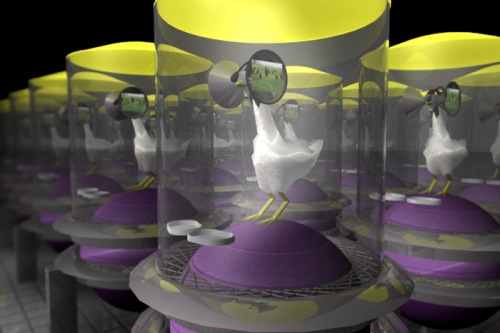When I shop for eggs, I wish to buy eggs which have not been factory farmed. I know that standard living conditions for factory farmed laying hens in the United States involve up to five hens being crammed into a wire cage approximately one foot cubed, suspended above a trough full of droppings. I appreciate the effort that the hens have put into creating those eggs for me to eat, and I do not show my appreciation for hard work by cramming birds into tiny spaces and watching them peck each other to death. I don’t know. Maybe I’m weird that way.
I want to fund the farmers who “pay” their laying hens (and any other animals they may have) with the standard package anyone should get for hard work: food, water, shelter, and medical care. The problem is finding these farmers, because all the other farmers (or, rather, the massive corporations who employ those farmers, who produce most of our commercially raised eggs) have figured out that most people don’t like picturing chickens crammed into little cages. They don’t want to actually stop doing that — that would be inconvenient and expensive for them — but they want us to think they have, so we’ll keep buying their eggs. So they use euphemisms.
They started by calling the eggs “organic”. That sounds nice. We associate “organic” with things made without pesticides, without additional hormones, without dosing the animals with unnecessary antibiotics. Surely animals being raised in “organic” conditions are happily out at pasture, frolicking with the butterflies? Nope. “Organic” does not imply a single thing about an animal’s housing conditions. “Organic” eggs may come from hens which are not chemically treated, or at least not chemically treated above and beyond some extremely loose standards set (sometimes) by the USDA, but the hens are still crammed in little cages. Little “organic” cages, possibly.
I’ve also heard “pesticide-free” and “vegan diet”. All right, those are nice — I’d prefer not to eat pesticide-laced chicken, and I know that some large factory farms feed their living animals the ground-up remains of their unusable, dead animals — but neither one really affects the day to day existence of the chickens. They’re still in little cages, although they are now a little less chemically altered, and less likely to catch horrible diseases from eating their ground-up predecessors on the assembly line.
A euphemism that’s becoming more popular now is “cage free”. That sounds good, doesn’t it? In fact, I bought “cage free” eggs (at twice the factory-farmed price) for a couple years before doing the research I should have done earlier. “Cage free” does mean that the chickens are not crammed into tiny cages, yes. But instead they are crammed shoulder to shoulder into huge barns, where they fight and have panic attacks every time the overhead lights turn on or off. (In fact, many barns are kept dark most of the time, to “calm” the birds.) They can technically move around, but there are thousands of other chickens in the way. This may be better than standard, but it is still hardly a bucolic idyll.
In a similar vein, I have seen eggs from hens with “outdoor access”. This means they cut a small hole in the side of the barn, with a yard about big enough for ten hens. The remaining 10,000 hens in the barn never see this hole, or the yard. But, technically, they have “outdoor access”.
The phrase which turns out to accurately describe “hens which are allowed to live much like hens should” is “pasture-raised” (or, as on the eggs that I buy, the legend “Our hens are kept on grass 24/7!”). This means the hens are actually, honestly, kept outdoors. It can be done, you know. Even with a couple of hundred hens. You bring them in at night and they lay eggs for you, and then during the day they go out and are hens. You rotate them to new pastures regularly, so the old ones have time to regrow and recover, and you get some fine eggs from those happy, happy hens.
You know the big corporations are not pasture-raising their hens. If they were, it would be all over the carton, because I am happy to pay six dollars a dozen for eggs if I know (and I do research to the best of my ability) that the hens which produced the eggs in question have been appropriately, handsomely paid for their work on my behalf, and I am sure the big corporations would love to get six dollars a dozen for their eggs. (Standard, factory farmed eggs in my area go for a dollar fifty to two dollars a dozen, normally.) Likewise, I pay twice the normal price for “pasture kept” milk and butter (“guaranteed kept on grass” and not “grass finished” or “organic” or “hormone-free”, although generally pasture-kept animals are also “organic” and “hormone-free” as well).
(I keep saying “the normal price” when I mean “the price of factory-farmed eggs”. This reflects somewhat on our culture, and it also annoys me. “Factory farmed” may be considered “normal” right now, but it should not be.)
Anyway, this whole mess offends me. It’s part of a bigger picture, where scientists replace “lab rat” with “animal model”, and use even more horribly twisted language to disguise, as much as possible, that they’re letting kids slice up live mice for fun. I can’t get into that right now, but this little mess, with “cage free” and “pasture”, is a start.




